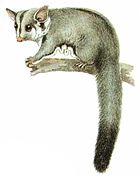
A wallaby is a small or middle-sized macropod native to Australia and New Guinea, with introduced populations in New Zealand, Hawaii, the United Kingdom and other countries. They belong to the same taxonomic family as kangaroos and sometimes the same genus, but kangaroos are specifically categorised into the four largest species of the family. The term "wallaby" is an informal designation generally used for any macropod that is smaller than a kangaroo or a wallaroo that has not been designated otherwise.

Diprotodontia is the largest extant order of marsupials, with about 155 species, including the kangaroos, wallabies, possums, koala, wombats, and many others. Extinct diprotodonts include the hippopotamus-sized Diprotodon, and Thylacoleo, the so-called "marsupial lion".

Tree-kangaroos are marsupials of the genus Dendrolagus, adapted for arboreal locomotion. They inhabit the tropical rainforests of New Guinea and far northeastern Queensland, along with some of the islands in the region. All tree-kangaroos are considered threatened due to hunting and habitat destruction. They are the only true arboreal macropods.
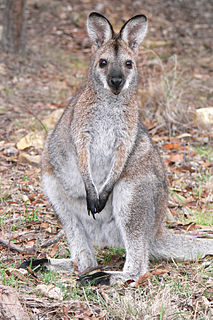
Macropodidae is a family of marsupials that includes kangaroos, wallabies, tree-kangaroos, wallaroos, pademelons, quokkas, and several other groups. These genera are allied to the suborder Macropodiformes, containing other macropods, and are native to the Australian continent, New Guinea and nearby islands.
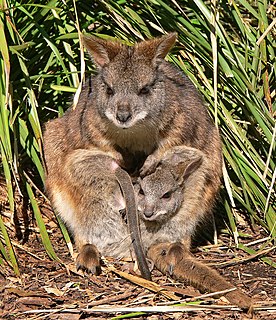
The parma wallaby is a small, hopping, kangaroo-like mammal native to forests of southeastern Australia. About the size of a stout cat, it lives in dense shrub and is only active at night to feed on grasses and small plants. It is the smallest of the wallabies and carries its young in a pouch like other marsupials. Shy and elusive, it was believed extinct until rediscovery in the 1960s. It is threatened by habitat loss and is easily killed by non-native foxes.

Pademelons are small, furry, hopping mammals in the genus Thylogale, found in Australia and New Guinea. They are some of the smallest members of the macropod family (Macropodidae), which includes the similar-looking but larger kangaroos and wallabies. Pademelons are distinguished by their small size and their short, thick, and sparsely-haired tails. Like other marsupials, they carry their young in a pouch.

Nothofagus, also known as the southern beeches, is a genus of 43 species of trees and shrubs native to the Southern Hemisphere in southern South America and Australasia. The species are ecological dominants in many temperate forests in these regions. Some species are reportedly naturalised in Germany and Great Britain. The genus has a rich fossil record of leaves, cupules, and pollen, with fossils extending into the late Cretaceous period and occurring in Australia, New Zealand, Antarctica, and South America. This genus was widespread throughout most of the Cenozoic of Australia and can still be found commonly in Eastern Australia and the island state of Tasmania where it is wetter.
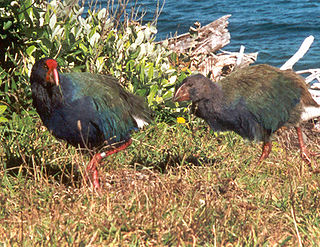
In paleontology, a Lazarus taxon is a taxon that disappears for one or more periods from the fossil record, only to appear again later. Likewise in conservation biology and ecology, it can refer to species or populations that were thought to be extinct, and are rediscovered. The term Lazarus taxon was coined by Karl W. Flessa & David Jablonski in 1983 and was then expanded by Jablonski in 1986. Wignall and Benton defined Lazarus taxa as, "At times of biotic crisis many taxa go extinct, but others only temporarily disappeared from the fossil record, often for intervals measured in millions of years, before reappearing unchanged". Earlier work also supports the concept though without using the name Lazarus taxon, like work by Christopher R. C. Paul.
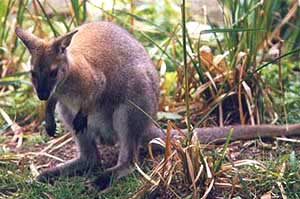
The Macropodiformes, also known as macropods, are one of the three suborders of the large marsupial order Diprotodontia. They may in fact be nested within one of the suborders, Phalangeriformes. Kangaroos, wallabies and allies, bettongs, potoroos and rat kangaroos are all members of this suborder.

The spectacled hare-wallaby is a species of macropod found in Australia and New Guinea. In Australia, a small sub-population is found on Barrow Island, while the mainland type is widespread, though in decline, across northern regions of the country.

Lagorchestes is a genus of small, rabbit-like mammals commonly known as hare-wallabies. It includes four species native to Australia and New Guinea, two of which are extinct. Hare-wallabies belong to the macropod family (Macropodidae) which includes kangaroos, wallabies, and other marsupials.

The western brush wallaby, also known as the black-gloved wallaby, is a species of wallaby found in the southwestern coastal region of Western Australia. The wallaby's main threat is predation by the introduced red fox. The IUCN lists the western brush wallaby as Least Concern, as it remains fairly widespread and the population is believed to be stable or increasing, as a result of red fox control programs.

Protemnodon is an extinct genus of megafaunal macropodids that existed in Australia, Tasmania, and New Guinea in the Pliocene and Pleistocene. It is also called the giant kangaroo.

Elseya is a genus of large side-necked turtles, commonly known as Australian snapping turtles, in the family Chelidae. Species in the genus Elseya are found in river systems in northern and northeastern Australia and throughout the river systems of New Guinea. They are identified by the presence of alveolar ridges on the triturating surfaces of the mouth and the presence of a complex bridge strut.
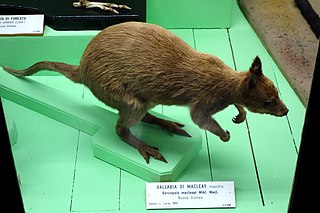
Macleay's dorcopsis, also known as the Papuan dorcopsis or the Papuan forest wallaby, is a species of marsupial in the family Macropodidae. It is endemic to Papua New Guinea, where its natural habitat is subtropical or tropical dry forests. Being little threatened by habitat destruction, the International Union for Conservation of Nature has rated it as being of "least concern".

Dorcopsulus is a genus of small marsupials in the family Macropodidae, known as forest wallabies. They are native to dry forests of New Guinea.

Calaby's pademelon, also known as the alpine wallaby, is a species of marsupial in the family Macropodidae. It is endemic to Papua New Guinea. It is threatened by habitat loss and hunting.
Cookeroo is a genus of extinct kangaroos from the Late Oligocene and Early Miocene found in fossil deposits from the Riversleigh World Heritage Area, in Australia. The genus includes two species, C. bulwidarri and C. hortusensis.
Watutia is an extinct genus of fossil kangaroo known from the Pliocene from New Guinea. It is only known from the type species Watutia novaeguineae, known from some fragmentary upper and lower jaws and isolated teeth from the Pliocene Otibanda Formation in the Morobe Province of Papua New Guinea. The closest relative of the genus was possibly Hadronomas, who lived in today's Queensland a few million years earlier. W. novaeguineae was about the size of a large shrub wallaby (Dorcopsis) and differs in some characteristics from the teeth of other kangaroos. The molars were low and the first premolars elongated. Cristids obliqua and posterior cingula are missing on the lower molars. The feature that defines the close association with Hadronomas was the upper first premolar, which was more bulbous with no lingual cingulum, differing it from most Macropods.
Dorcopsoides is a genus of extinct species of kangaroo from the Pliocene of Australia.

















